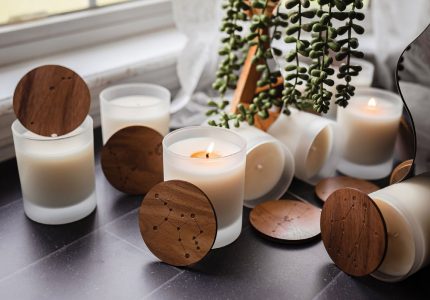
December 29, 2025 | Sustainable Home Tips
Your home should be a safe haven, but what if we told you that lurking beneath that fresh coat of paint or inside your cozy couch are hidden toxins quietly affecting your air quality, health, and overall well-being? From VOCs in paints to BPA in plastics, many everyday household products contain chemicals that aren’t doing you (or the planet) any favors.
Luckily, making sustainable swaps is easier than ever. Let’s break down the most common hidden toxins in your home and how to replace them with eco-friendly alternatives that are better for you and your space.

Images by Kelli
The Problem: VOCs are chemicals found in traditional paints, finishes, and adhesives. They evaporate into the air over time, causing poor indoor air quality and potential respiratory issues.
Sustainable Swap: Choose low-VOC or zero-VOC paints from brands like Benjamin Moore Natura or ECOS Paints. Look for Green Seal-certified options when refinishing furniture or walls.
DIY Solution: If you want to refresh an old piece of furniture, opt for natural finishes like beeswax polish or linseed oil, both of which are toxin-free and biodegradable.
The Problem: Found in plastic containers, canned food linings, and even some water bottles, BPA and phthalates are endocrine disruptors linked to hormone imbalances.
Sustainable Swap: Switch to glass or stainless steel food storage, BPA-free cans, and reusable silicone bags from brands like Stasher. Check labels to ensure products are BPA-free and phthalate-free.
Pigybak Tip: Consider organizing a neighborhood plastic-free challenge through Pigybak, where you and your neighbors commit to reducing plastic waste together.
The Problem: Many sofas, mattresses, and carpets contain toxic flame retardants that release harmful chemicals over time, impacting air quality and long-term health.
Sustainable Swap: When upgrading furniture, look for brands offering Greenguard Gold Certified products or natural flame-resistant materials like wool and organic cotton. Check out Avocado Green Mattress or Savvy Rest for non-toxic bedding.
DIY Alternative: If you’re not ready to replace furniture, use a vacuum with a HEPA filter to reduce toxin buildup in upholstery and rugs.
The Problem: That “clean linen” or “ocean breeze” candle might be filling your home with phthalates and harmful synthetic fragrances that contribute to allergies and headaches.
Sustainable Swap: Opt for beeswax or soy candles scented with essential oils, or use reusable diffusers with pure essential oil blends from brands like Vitruvi or P.F. Candle Co..
DIY Hack: Simmer a pot of water with cinnamon sticks, orange peels, and cloves for an all-natural, toxin-free home fragrance.
The Problem: Traditional cleaning products are loaded with harsh chemicals like ammonia, chlorine, and formaldehyde, which linger in the air and can irritate your skin and lungs.
Sustainable Swap: Make the switch to plant-based, biodegradable cleaners from brands like Blueland or DIY your own with vinegar, baking soda, and lemon juice.
Pigybak Tip: Organize a neighborhood green cleaning swap through Pigybak, where community members trade eco-friendly cleaning recipes and products.
The Problem: Conventional produce and lawn treatments often contain harmful pesticides that contribute to soil and water pollution while being absorbed into the food you eat.
Sustainable Swap: Choose organic, locally sourced produce whenever possible. For lawns and gardens, go for natural compost, neem oil, or organic fertilizers instead of chemical-heavy options. Need help? Pigybak’s neighborhood group deals can help you find eco-friendly lawn care services near you!
DIY Alternative: Start a compost bin with food scraps and lawn clippings to create nutrient-rich soil naturally.
The Problem: Traditional non-stick cookware is often coated in perfluorinated chemicals (PFCs), which can release toxic fumes when overheated.
Sustainable Swap: Invest in cast iron, stainless steel, or ceramic cookware as a non-toxic, long-lasting alternative. Brands like GreenPan offer safe, eco-friendly options.
DIY Solution: If you already own non-stick pans, cook at low-to-medium heat to reduce chemical release.
Sustainability isn’t just about big changes—it’s about the small, mindful swaps that add up over time. Whether you’re tackling a full-blown home renovation or just looking to replace toxic everyday products, Pigybak can help you connect with eco-conscious home service providers who get the job done right. Check out how Pigybak is changing the game for home services here.
Ready to make your home healthier? Join Pigybak today and let’s make sustainability simple, one home at a time.
I, [Customer Name], hereby authorize Pigybak to include my name, phone number, and address in their database. I also opt-in to receive notifications about upcoming services in my area. I validate that the information provided is accurate and represents my personal information, not others.
By providing this authorization, I understand and agree to the following terms:
I authorize Pigybak to set up a profile on my behalf, which may include my name, phone number, and address.
I consent to receiving notifications from Pigybak about upcoming services in my area via text message.
I acknowledge that I have the option to opt out of receiving notifications at any time. I can do so by directly contacting the contractor or managing my preferences in the Pigybak app.
I authorize Pigybak to share my contact information with the contracted service providers for the purpose of facilitating service delivery.
Pigybak agrees not to share my information with third parties without obtaining separate authorization from me.
I understand that Pigybak may update the terms and conditions, and I agree to review them periodically for any changes.
I acknowledge that the standard terms and conditions of the Pigybak mobile application, which can be found at www.pigybak.com/privacy-policy, apply to this authorization.
I acknowledge that this authorization is voluntary, and I have read and understood the terms outlined above. By providing my information, I consent to the terms above.

